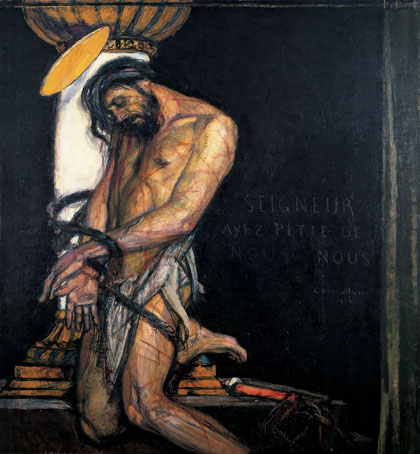| News |
<
|
28 March 2012
|
>
|
|
Musée d'Orsay - Wednesday March 28th 2012 |
|
The Christ à la colonne has been displayed at the Musée d'Orsay in the gallery dedicated to Symbolism since Monday March 26th. The pastel Tireurs à l'arc is is back in the storerooms for preservation reasons. As Holy Week approaches, it offers us a beautiful meditation: Christ shares his suffering for humanity next to l’Ascension du Poilu.  © Musée d'Orsay, Paris |
|
R.E.D., Art in France, in: The Burlington Magazine for Connoisseurs, London, October 1910-March 1911, vol. XVIII, p.125-127 : "[...] Among works of different tendency to be noticed is the painful but very remarkable Christ at the pillar of M. Georges Desvallières. [...]" SALON D’AUTOMNE 1910 -- p.104 -- Christ at the Whipping-Post 1910 Oil on canvas, (161 x 149 cm) signed and dated at the centre (on the right): George Desvallières 1910 Musée d’Orsay
The portrayals of Christ’s Passion made their appearance in George Desvallières’ work following his illustrations for Alfred de Musset’s Rolla [pp.75-77]. The painter embarks on this new subject with his Christ at the Whipping-Post on his return from Spain, whose 17th century iconography offers many portrayals of Christ after the flagellation. Thus like Velasquez in 1632 (1), Desvallières portrays a Christ out of breath, roped to a whipping-post. Having visited Avila, Salamanca and Segovia in June 1910, he found an echo to his troubled Christianity in the dolorous character of the paintings by El Greco and Valdès Real. The entire body of his Christ bears the traces of his blood following flagellation. The inscription painted on the dark background reading: “Seigneur, ayez pitié de nous”, “Lord, have mercy on us”, stresses the bitterness of religious feeling which from the beginning inspired his artistic apostolate.
This picture which belonged to Maurice Denis from 1914 onwards, was (since 1980) at the Musée du Prieuré de Saint Germain-en-Laye, thanks to a State Loan. As Vallery-Radot stressed in L’Art et les Artistes, its pathetic style offers here a striking contrast with the happier works of the “prophets of the beautiful icons” (2): “ Anyone who has once seen the Christ at the Whipping-PSost shining forth in the Prieuré de Saint Germain (in the Great Hall of Maurice Denis – the famous friend of the painter) will never be able to forget the flagellated body that curves like a yellow flame purpled with blood against the cruel white of the whipping-post […]. It is no doubt on purpose that the painter of Franciscan joys and Easter mornings decided to place this severe portrayal in the middle of such delightful incantations (3).” Painted in the year of Desvallières’ joining the Société de Saint Jean pour l’Encouragement de l’Art Chrétien, the Christ at the Whipping-Post foretells the renewal that would be carried out by the Ateliers d’Art Sacré as from 1919. Although their styles are different, Denis and Desvallières, committed to their Faith, share the same aspiration to modernise the “sacristy style” (4) they both condemn. This work, shown at the first exhibitions of Christian Art of the between-the-wars period, and reproduced in the form of devotional imagery, is highly significant of an approach to combining the Christian tradition with independent contemporary art. Isabelle Collet, Conservateur en chef au Petit Palais, Département des peintures.
(1) Velazquez’ Christ at the Whipping-Pillar can be seen at the National Gallery in London since 1883. (2) Nickname given to Maurice Denis by his “nabi”(prophet) friends. (3) Robert Vallery-Radot: “George Desvallières” L’Art et les Artistes, October 1929, p. 26. (4) An expression used by Maurice Denis. Copyright © Catherine Ambroselli de Bayser, March 2012. |